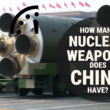Nuclear security: From summits to mechanisms
By Hubert Foy, May 5, 2016
The idea behind the Nuclear Security Summits was to prevent terrorist groups such as the Islamic State from gaining access to nuclear weapons, fissile materials, and nuclear facilities. But nuclear security is never "done"—not as long as fissile and radiological materials exist—so even now, with the summit process complete, the threat of nuclear terrorism is not necessarily diminishing. Truth is, the risk of nuclear terrorism cannot be eliminated. But if states make the utmost commitment to protecting nuclear materials, nuclear security can be continuously improved. The 2016 summit in Washington eased the way toward continuous improvement by establishing a set of nuclear security mechanisms that all states can join and all can implement—even without summits.
One such mechanism is the Nuclear Security Contact Group, created via a joint statement by 40 of 52 governments represented in Washington. The group is envisioned as a tight-knit community focused on synchronizing efforts toward implementing the summit agenda, and it is to meet annually on the sidelines of the General Conference of the International Atomic Energy Agency. Michael H. Fuchs, my roundtable colleague, has argued that nuclear security meetings in which heads of state do not participate might be inadequate to preserve momentum in nuclear security. Fuchs concedes, however, that if biennial summits involved ministers of foreign affairs and energy, they would likely gain the support of relevant national agencies and attract meaningful public attention. As it happens, the Nuclear Security Contact Group will be composed of "appropriately authorized and informed senior… officials," as Fuchs envisions that such a group ought to be. Significantly, group members may recommend to national leaders that additional Nuclear Security Summits be convened. And—importantly for nations such as my own Cameroon, which has not been part of the summit process—the contact group will be open to non-summit countries that wish to participate in the summit agenda.
Another significant mechanism concerns best practices for sharing nuclear security information. This mechanism, established in Washington through a joint statement by 17 countries, includes a consolidated national reporting form that enables states to report on nuclear security in a consistent manner. But the form can also take into account varying national circumstances—different nations, for example, have committed to different international instruments. Using the form as a template, states will more readily be able to meet their reporting requirements, making their nuclear security activities more sustainable. The mechanism will also, by increasing transparency, build international confidence in the effectiveness of nations' nuclear security regimes.
Finally, the 2016 summit resulted in five action plans intended to transfer segments of the summit agenda to existing nuclear security institutions. For states that belong to these institutions, the action plans represent mechanisms for playing enhanced roles in improving nuclear security. The plan established for the United Nations, for example, calls for increased efforts to fully implement Security Council Resolution 1540 (which obliges states not to support the ambitions of non-state actors seeking access to weapons of mass destruction). Initiatives such as these allow states that did not participate in the summit process to get involved now.
To be sure, fora for collective action on nuclear security extend beyond the institutions involved in the action plans. They also include the nuclear industry, professional societies, and communities of nongovernmental experts. These are all key components in the nuclear security architecture, and they can nurture new ideas while helping professionals build their skills and establish global connections.
In the post-summit era, a danger exists that President Obama’s vision for reducing the threat of nuclear terrorism won't be pursued vigorously enough. Nuclear security could decline dangerously. But these outcomes can be avoided if nations challenge themselves to implement commitments made during the summit process—and if the mechanisms growing out of the 2016 summit are utilized as they deserve to be. The mechanisms are designed to perpetuate some of the summit process's most important attributes: the ability to attract sustained, personal attention from national leaders; a format capable of eliciting commitments from participating countries; and a focus on tangible, meaningful outcomes.
Share: [addthis tool="addthis_inline_share_toolbox"]














